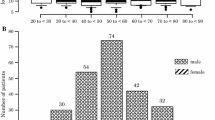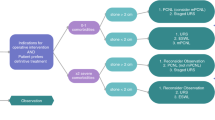Abstract
The aim of the study was to evaluate the impact of age on the efficacy of extracorporeal shock wave lithotripsy (SWL), in a comparative study based on the principles of matched-pair analysis. Over a period of 4 years, 2,311 patients were treated with SWL in a tertiary referral center. Patient and stone data were recorded in a prospective electronic database. Among these patients, 115 (4.97%) were older than 70 years of age and fulfilled the criteria for inclusion in the study (Group A). For the purposes of the comparative analysis, Group A patients were matched for gender and stone parameters (side, location of stone, and diameter ±2 mm) with a control group of patients under the age of 70 (Group B). Following matching, the patients’ electronic medical records were reviewed, to identify SWL success rates at 3 months and McNemar’s test was used to compare the efficacy of SWL between the two groups. Matching was possible in all cases. The results indicate that there were no statistically significant differences in the mean number of SWL sessions or in the mean number of impulses per session between the two groups. The overall stone clearance rate achieved by SWL alone was 71.3% for Group A and 73.9% for group B. Discordant pairs were found in 37 cases (in 17 pairs only patients in Group A became stone-free, while in 20 pairs only patients in Group B became stone-free). By using McNemar’s test, the difference in stone clearance rates between the two groups was not found to be statistically significant (p = 0.742). A total of 22 patients (19.1%) in Group A and 17 patients (14.7%) in Group B underwent an adjuvant procedure to achieve stone clearance. McNemar’s test also revealed the absence of any statistically significant difference in SWL success rates between older and younger patients in the subgroups of patients presenting with either ureteric or renal stones (p = 0.727 and p = 0.571, respectively). In conclusion, SWL is still considered one of the first-line tools for geriatric patients suffering from urolithiasis, as increased age alone does not seem to adversely affect the efficacy of SWL.
Similar content being viewed by others
References
Preminger GM, Tiselius HG, Assimos DG, Alken P et al (2007) Guideline for the management of ureteral calculi. Eur Urol 52:1610–1631
Ng CF (2009) The effect of age on outcomes in patients undergoing treatment for renal stones. Curr Opin Urol 19:211–214
Gentle DL, Stoller ML, Bruce JE, Leslie SW (1997) Geriatric urolithiasis. J Urol 158:2221–2224
Usui Y, Matsuzaki S, Matsushita K, Shima M (2003) Urolithiasis in geriatric patients. Tokai J Exp Clin Med 28:81–87
Kramolowsky EV, Quinlan SM, Loening SA (1987) Extracorporeal shock wave lithotripsy for the treatment of urinary calculi in the elderly. J Am Geriatr Soc 35:251–254
Sighinolfi MC, Micali S, Grande M, Mofferdin A, De Stefani S, Bianchi G (2008) Extracorporeal shock wave lithotripsy in an elderly population: how to prevent complications and make the treatment safe and effective. J Endourol 22:2223–2226
Halachmi S, Meretyk S (2006) Shock wave lithotripsy for ureteral stones in elderly male patients. Aging Male 9:171–174
Ackermann DK, Fuhrimann R, Pfluger D, Studer UE, Zingg EJ (1994) Prognosis after extracorporeal shock wave lithotripsy of radiopaque renal calculi: a multivariate analysis. Eur Urol 25:105–109
Abdel-Khalek M, Sheir KZ, Mokhtar AA, Eraky I, Kenawy M, Bazeed M (2004) Prediction of success rate after extracorporeal shock-wave lithotripsy of renal stones—a multivariate analysis model. Scand J Urol Nephrol 38:161–167
Gomha MA, Sheir KZ, Showky S, Abdel-Khalek M, Mokhtar AA, Madbouly K (2004) Can we improve the prediction of stone-free status after extracorporeal shock wave lithotripsy for ureteral stones? A neural network or a statistical model? J Urol 172:175–179
Delakas D, Karyotis I, Daskalopoulos G, Lianos E, Mavromanolakis E (2003) Independent predictors of failure of shockwave lithotripsy for ureteral stones employing a second-generation lithotripter. J Endourol 17:201–205
Kanao K, Nakashima J, Nakagawa K, Asakura H, Miyajima A, Oya M, Ohigashi T, Murai M (2006) Preoperative nomograms for predicting stone-free rate after extracorporeal shock wave lithotripsy. J Urol 176:1453–1456
Ng CF, Wong A, Tolley D (2007) Is extracorporeal shock wave lithotripsy the preferred treatment option for elderly patients with urinary stone? A multivariate analysis of the effect of patient age on treatment outcome. BJU Int 100:392–395
Weinstein JR, Anderson S (2010) The aging kidney: physiological changes. Adv Chronic Kidney Dis 17:302–307
Argyropoulos AN, Tolley DA (2010) Evaluation of outcome following lithotripsy. Curr Opin Urol 20:154–158
Portis AJ, Yan Y, Pattaras JG, Andreoni C, Moore R, Clayman RV (2003) Matched pair analysis of shock wave lithotripsy effectiveness for comparison of lithotriptors. J Urol 169:58–62
Stewart GD, Bariol SV, Moussa SA, Smith G, Tolley DA (2007) Matched pair analysis of ureteroscopy vs. shock wave lithotripsy for the treatment of upper ureteric calculi. Int J Clin Pract 61:784–788
Youssef RF, El-Nahas AR, El-Assmy AM, El-Tabey NA, El-Hefnawy AS, Eraky I, El-Kenawy MR, El-Kappany HA, Sheir KZ (2009) Shock wave lithotripsy versus semirigid ureteroscopy for proximal ureteral calculi (<20 mm): a comparative matched-pair study. Urology 73:1184–1187
Argyropoulos AN, Tolley DA (2009) Ureteric stents compromise stone clearance after shockwave lithotripsy for ureteric stones: results of a matched-pair analysis. BJU Int 103:76–80
Knapp PM, Kulb TB, Lingeman JE, Newman DM, Mertz JH, Mosbaugh PG, Steele RE (1988) Extracorporeal shock wave lithotripsy-induced perirenal hematomas. J Urol 139:700–703
Dhar NB, Thornton J, Karafa MT, Streem SB (2004) A multivariate analysis of risk factors associated with subcapsular hematoma formation following electromagnetic shock wave lithotripsy. J Urol 172:2271–2274
Newman LH, Saltzman B (1991) Identifying risk factors in development of clinically significant post-shock-wave lithotripsy subcapsular hematomas. Urology 38:35–38
Ikegaya H, Kato A, Kumano S, Tominaga T (2005) Correlation between age and the efficacy of ESWL. BJU Int 96:1145
Conflict of interest
None.
Author information
Authors and Affiliations
Corresponding author
Rights and permissions
About this article
Cite this article
Philippou, P., Lamrani, D., Moraitis, K. et al. Is shock wave lithotripsy efficient for the elderly stone formers? Results of a matched-pair analysis. Urol Res 40, 299–304 (2012). https://doi.org/10.1007/s00240-011-0424-4
Received:
Accepted:
Published:
Issue Date:
DOI: https://doi.org/10.1007/s00240-011-0424-4




